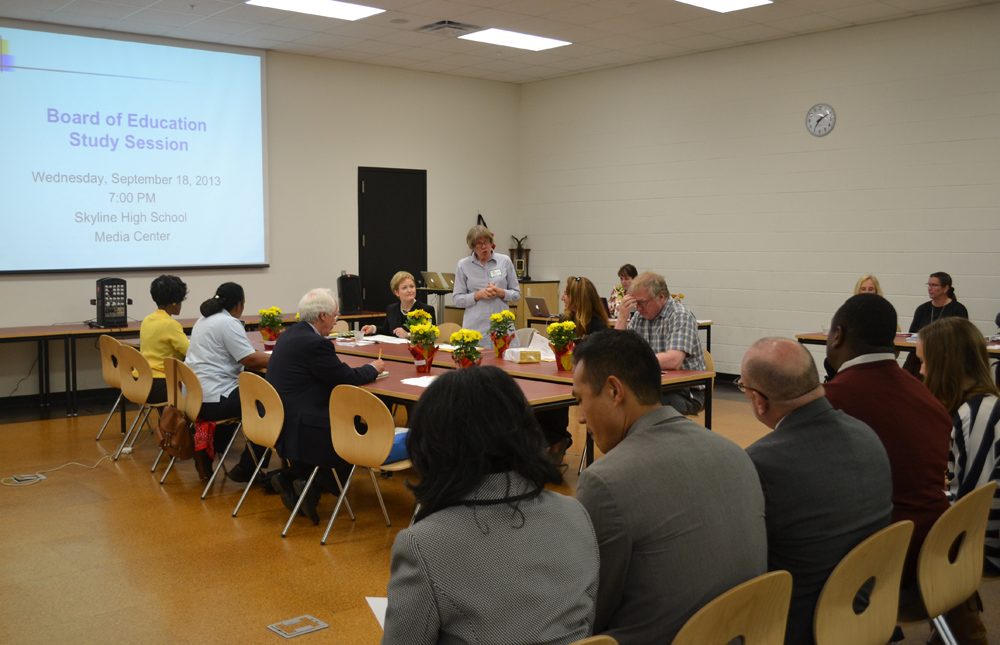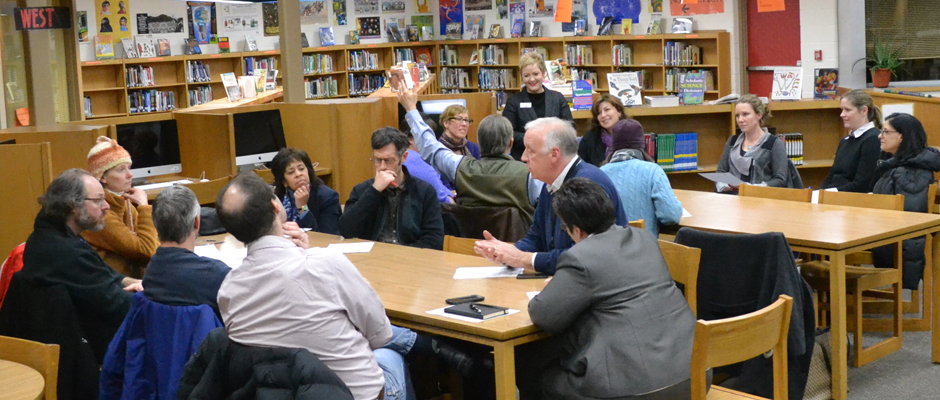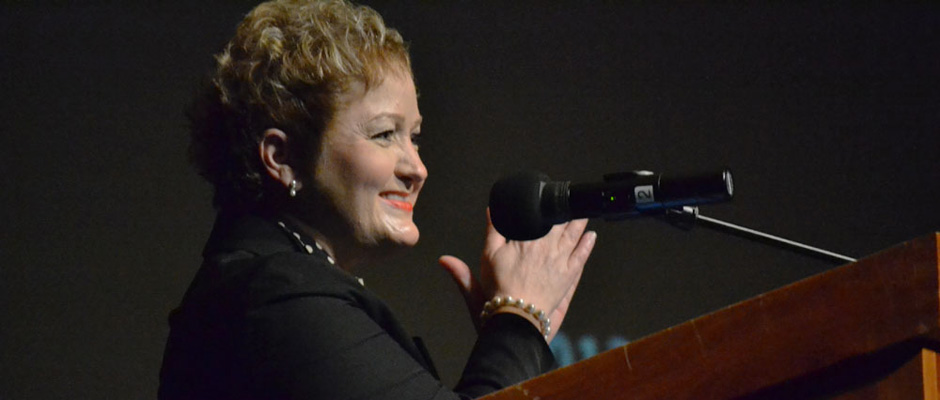
By Tara Cavanaugh
At the Board of Education study session Sept. 18, district officials shared some of the positive developments so far in the 2013-2014 school year: a successful Opening Day kickoff, new principals at six schools and the new superintendent’s upcoming community meetings at all buildings.
District officials also shared developments that are being analyzed and worked on: enrollment and class sizes, transportation issues, and the superintendent’s entry plan. Superintendent Dr. Jeanice Swift, Deputy Superintendent for Instruction Alesia Flye, Director of Student Accounting and Research Jane Landefeld and Communications Director Liz Margolis discussed these issues with the AAPS News ahead of the Wednesday night study session.
Enrollment and Class Sizes: What Do the Numbers Mean?
Imagine a large crowd –– say, 16,000 people –– filtering into a concert hall. They shuffle past one another to find their seats. Sometimes they switch seats for a better view. Some will show up late. Some will leave early.
It would be a little tricky to pinpoint who sat exactly where, right?
It’s a similar situation for counting each and every student in the district, especially as the school year begins. This is why AAPS officials stress that current class sizes and enrollment numbers are preliminary.
Officials also stress the need to look at overall trends in student enrollment.
Enrollment trends
Preliminary numbers show that this year the district has 16,297 students enrolled in the district. The enrollment is 210 less than last year. That’s about a 1.2 percent decrease.
“One drop doesn’t make a trend,” said Jane Landefeld, the district’s director of student accounting and research.
In fact, the district is bucking the statewide trend: in the four school years between 2008 and 2012, AAPS increased its K-12 enrollment by 1.3 percent while the state decreased its K-12 enrollment by 6.2 percent.
During the same four-year period, the district increased its kindergarten enrollment 4.5 percent while the state’s decreased 2.4 percent.
Another trend that is positive is the increase in school of choice applicants and enrollments. AAPS has seen applications and enrollees increase threefold during the past three years thanks to families choosing our schools. “School of Choice options are helping maintain our enrollment,” Landefeld said.
A trend that has been consistent is AAPS kindergarten enrollment in relation to Washtenaw County’s birth rate. The district is able to predict its kindergarten enrollment based on the birth rate (this year’s birth rate will affect the size of the AAPS kindergarten class in 2018, when this year’s newborns will be age five).
For the past nine years, AAPS has been able to count on enrolling between 28 and 32.5 percent of all children born in the county five years prior.
This year, total kindergarten enrollment decreased by 11 students; 142 left the district before starting first grade while 131 enrolled. Landefeld analyzed the reasons that those 142 students left the district and found that half moved out of the state or out of the country.
Forty-two percent moved out of the district within the state, 9 percent enrolled in private schools and 9 percent enrolled in charters. (Similar analysis is currently being conducted for each grade beyond kindergarten.)
Interestingly, 114 — 80 percent — of those 142 students moved residences.
Landefeld also points out that a majority of the total 210 students who left the district, 145 of them, were lost at the secondary level (grades 6-12). One possible cause is increasing academic opportunities: this year 80 AAPS students enrolled in the WISD high school programs: the Early College Alliance, the Washtenaw International High School and the Widening Advancements for Youth.
“That number (80) will keep growing, and those are students who would have been in our buildings,” Landefeld said.
How have class sizes been affected?
A continual decrease in state funding has affected the district’s extracurricular offerings, amount of educational support staff (such as teaching assistants) and, to some extent, class sizes.
State funding for AAPS has been cut by $43 million over the past five years, including this current school year, said Nancy Hoover, the district’s director of finance. AAPS has had to reduce 34 teaching positions since last school year.
The district starts to review class sizes when numbers reach beyond 23 in kindergarten, 28 in grades 1 and 2, and 30 in grades 3-5. The elementary schools’ class sizes have changed this year in ways that are neither entirely positive or negative.
This year there are fewer kindergarten classes with more than 23 students (13 last year, seven this year). There are also fewer classes in grades 1-5 with over 30 students (10 last year, six this year).
The secondary schools’ numbers in core classes are monitored. Core classes are English, math, science, social studies and world languages. Class sizes are reviewed by the district when numbers go beyond 33 in each class.
In the middle schools classes this year, there are four more classes that have over 33 students (28 this year, 24 last year). However, the change in the middle schools has been mostly positive: there are fewer classes with 31-33 students (128 last year, 116 this year) and more classes with 25-30 students (273 last year, 294 this year).
The high schools show class sizes of 33 students or less, on average, in 78 percent of all core classes between Community, Huron, Skyline and Pioneer.
Addressing large class sizes
District officials, including Superintendent Dr. Jeanice Swift, have been touring the schools and paying close attention to class sizes as they fluctuate early on in the school year.
Deputy Superintendent for Instruction Alesia Flye said that schools are continuing to add online learning options and distance learning labs, such as a new Chinese class at Pioneer, to accommodate student requests for low-enrolled classes.
Flye also said that the district is offering additional professional development opportunities for teachers who are providing instruction in split classes (with two grades) at the elementary level.
Flye stressed that student learning continues to be strengthened through strong community partnerships, such as the Mitchell-Scarlett Teaching Learning Collaborative with the University of Michigan and the World Language Partnership with U-M.
Transportation Update
This is the second year the district has worked with AATA to provide student transportation to schools. AATA took on three more AAPS bus routes this fall.
“AATA is becoming a popular service for our students, especially our secondary students, to use,” said AAPS Communications Director Liz Margolis.
“Our priority is student safety and effective communication,” said Superintendent Dr. Swift.
Dr. Swift and other administrators met with concerned parents in the Arbor Hills at Clague Middle School on Sept. 17 neighborhood to discuss student walk routes.
Green Road, a part of an Arbor Hills student’s walk route to Clague, has had many improvements for pedestrian travel during the past year, including three new pedestrian walkways with lights; one of the walkways includes an island.
After being informed of concerns, the district also added three bus stops: on Ford Road, the Maple and Wagner area, and PineLake housing.
Superintendent’s Community Forums
Superintendent Dr. Swift announced the first three dates of her community forums. They will take place at Angell Elementary on Sept. 19, Mitchell Elementary on Sept. 26 and Bach Elementary on Sept. 30 from 6:30 to 8 p.m.
Attendees of the meetings will be asked to consider four questions in small groups:
- What is going well in the district and what are we proud of?
- What areas need our attention?
- What do we dream of and hope to achieve for our children and AAPS over the next 10-15 years?
- What are the top 3 priorities you would like Dr. Swift to address?
A full list of dates, times and locations is now available on the district website. If you can’t make your own school’s scheduled forum, please feel free to attend any of the other scheduled events.





The transportation update mentions AATA took on three more bus routes this year, but fails to mention how many total bus routes it now handles for AAPS. How many bus routes does AATA handle for AAPS this year?
David, I just checked with Liz Margolis, the district’s communications director, and she said that AATA now handles 6 total routes for AAPS.
Addressing large class sizes: I am concerned that online learning is thought of as a way to reduce class size – assuming that the issue here is the number of instructors we lost due to financial problems. I have taken over 70 credits worth of online classes from 2 different universities (Boston U has the BEST courses). I have had many different instructors. I love online learning; however, there are several elements to effective instruction that take heavy facilitator involvement. Online learning reduces the number of students physically in the room, but it increases the amount of time an instructor spends interacting with students.
1. Instructors who attempt to teach online courses with a classroom format are not effective. The same format just does not translate. I do not know how much time is needed to develop a new format, but I bet it is more than most would estimate. I had a few online classes that were on their third iteration as the instructors learned what worked best. I could sense their struggles.
2. I am more engaged in an online course than in a classroom because the instructors require regular interaction. Well taught courses require a minimum of 2 – 3 posts per week based on course assignments plus responses to 2 – 3 other students’ posts. Someone must review every post to ensure meaningful dialog, original thinking, etc. Grades are often assigned.
3. Fabulous instructors respond to every student’s response to assigned posts. Good instructors respond to around 75% of the posts. The benefits of this out weigh classroom instruction because students see everyone’s responses to assignment questions along with the instructor’s feedback. Students learn so much more this way. There simply is not enough time to cover so much in a classroom setting.
4. Effective testing is usually in essay format. Instructors assume students have all of the course materials available so writing is the typical format of an effective test rather than multiple choice, etc., . I imagine this method takes considerable more time to correct than other formats. (I also benefited significantly from the exercise of writing, writing, writing…)
I could go on, but I will get off my ‘soap box.’ I am interested to learn 1) whether my assumption for larger class sizes correct 2) the ways in which instructors are managing the demands of online learning.